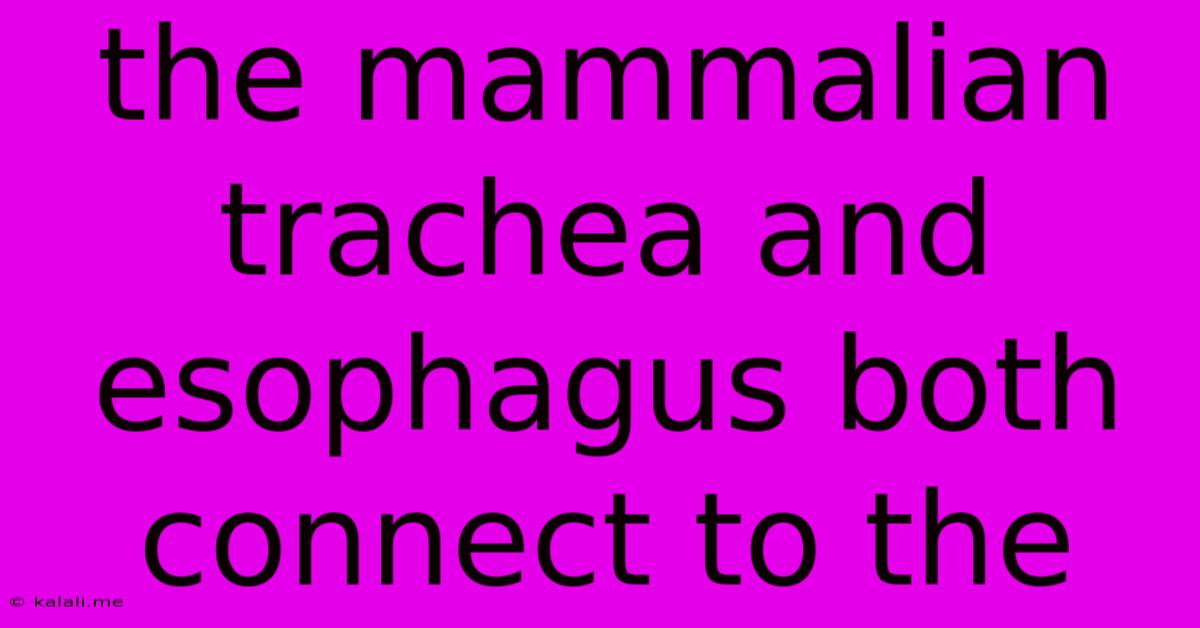The Mammalian Trachea And Esophagus Both Connect To The
Kalali
Jun 15, 2025 · 3 min read

Table of Contents
The Mammalian Trachea and Esophagus: Where They Meet and How They Differ
The mammalian trachea and esophagus are two vital tubes located in the neck and upper chest, both crucial for survival. While they share close proximity and a common entry point, understanding their distinct functions and anatomical relationships is key to comprehending their overall role in the respiratory and digestive systems. This article will delve into the shared connection point of these two crucial tubes and highlight their key differences.
The Pharynx: The Shared Junction
The answer to the question posed in the title is the pharynx. The trachea and esophagus both connect to the pharynx, a muscular tube located at the back of the throat. This is the common pathway for both air and food, making it a crucial area for coordination to prevent choking and ensure efficient passage of both substances. The pharynx acts as a sort of "crossroads," directing ingested food into the esophagus and inhaled air into the trachea. This critical junction highlights the delicate balance and intricate coordination required for proper respiratory and digestive function. Understanding the anatomy of the pharynx is essential to understanding how this coordination occurs.
Understanding the Pharyngeal Structures
The pharynx itself is divided into three regions: the nasopharynx (behind the nose), oropharynx (behind the mouth), and laryngopharynx (behind the larynx). The laryngopharynx is particularly important in this context because it's the point where the trachea and esophagus diverge. The epiglottis, a flap of cartilage, plays a crucial role in this separation. During swallowing, the epiglottis folds down to cover the opening of the larynx (the voice box), preventing food from entering the trachea and triggering a potentially life-threatening choking event. This intricate mechanism ensures that food is properly directed into the esophagus while the airway remains unobstructed.
The Trachea: The Airway
Once air passes through the larynx, it enters the trachea, also known as the windpipe. This is a rigid tube reinforced with C-shaped cartilage rings, giving it structural support and preventing it from collapsing. The trachea's primary function is to conduct air to and from the lungs. Its smooth, mucus-lined interior helps to filter and humidify the incoming air, protecting the delicate lung tissue. The cilia, tiny hair-like structures lining the trachea, also help to trap and remove foreign particles and debris. This efficient filtration system is critical to maintaining respiratory health.
The Esophagus: The Food Pipe
The esophagus, on the other hand, is a muscular tube responsible for transporting ingested food from the pharynx to the stomach. Unlike the trachea, the esophagus is more flexible and lacks the rigid cartilage support. Its muscular walls use peristaltic movements – coordinated waves of muscle contraction – to propel food downwards. This process is essential for efficient digestion and preventing food reflux back into the pharynx. The smooth lining of the esophagus also helps food move smoothly, reducing the risk of irritation or injury.
Key Differences Summarized
To emphasize the distinct nature of these two tubes, let's summarize their key differences:
- Function: Trachea conducts air; Esophagus transports food.
- Structure: Trachea is rigid with cartilage rings; Esophagus is flexible and muscular.
- Lining: Trachea is lined with cilia and mucus; Esophagus has a smooth lining.
- Movement: Trachea is passive; Esophagus uses peristalsis.
Understanding the close relationship and yet distinct functions of the trachea and esophagus, particularly their shared origin in the pharynx, is vital for appreciating the complex coordination necessary for proper breathing and digestion. The precise mechanism for diverting food and air is a marvel of anatomical engineering, emphasizing the importance of this shared junction.
Latest Posts
Latest Posts
-
What Is The Gas Released During Photosynthesis
Jun 15, 2025
-
The Number Of Atoms In 1 Mol Of Carbon Is
Jun 15, 2025
-
At What Speed Does Sound Travel In A Vacuum
Jun 15, 2025
-
What Is The Major Product Of The Following Reaction Hcl
Jun 15, 2025
-
What Wave Has The Shortest Wavelength
Jun 15, 2025
Related Post
Thank you for visiting our website which covers about The Mammalian Trachea And Esophagus Both Connect To The . We hope the information provided has been useful to you. Feel free to contact us if you have any questions or need further assistance. See you next time and don't miss to bookmark.